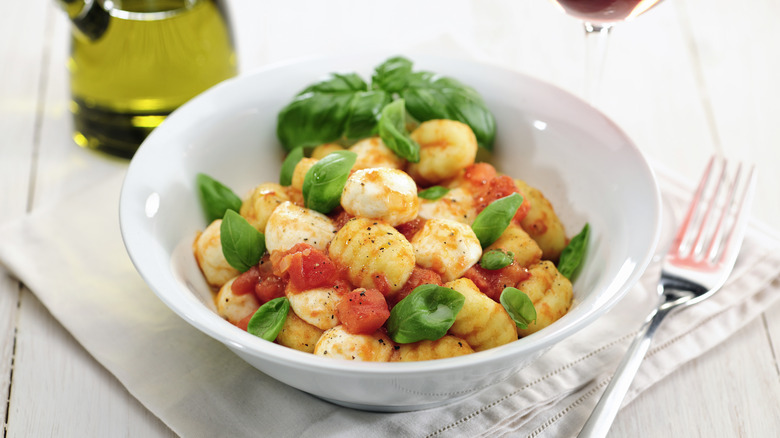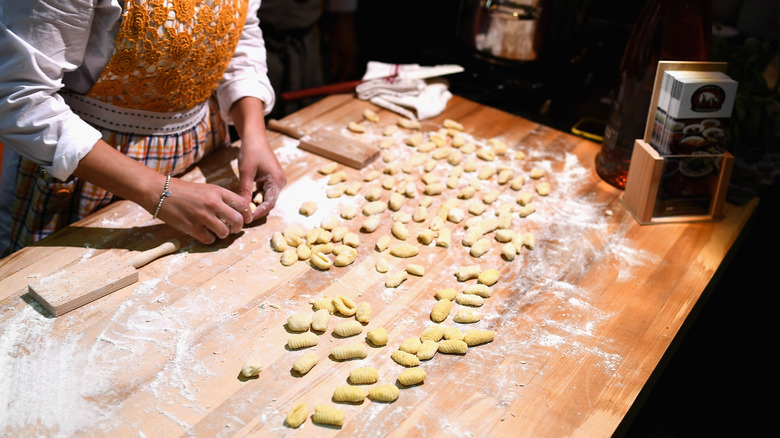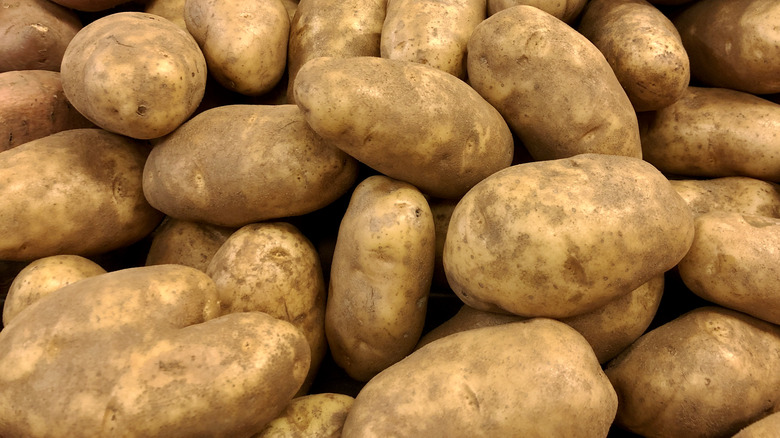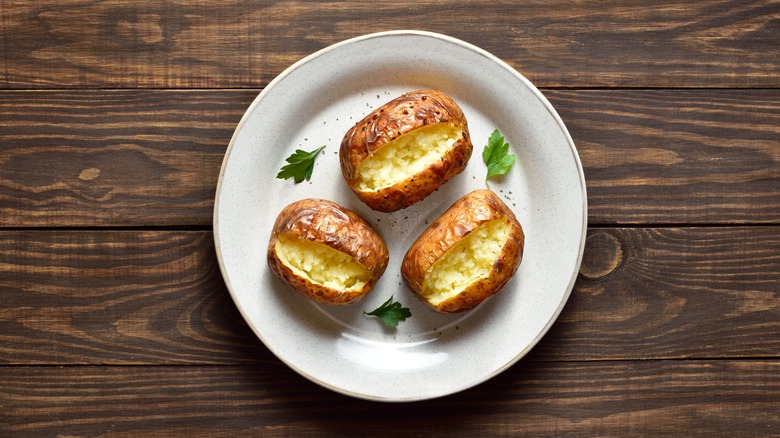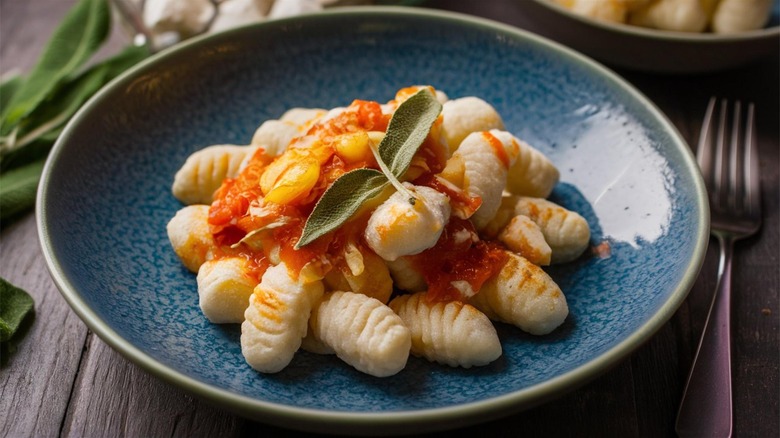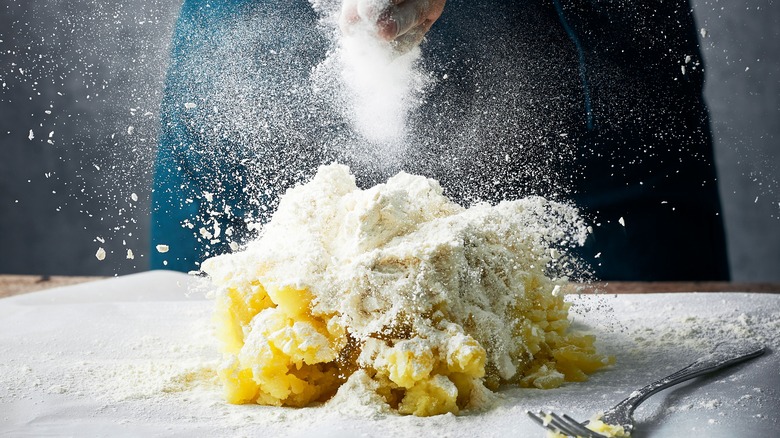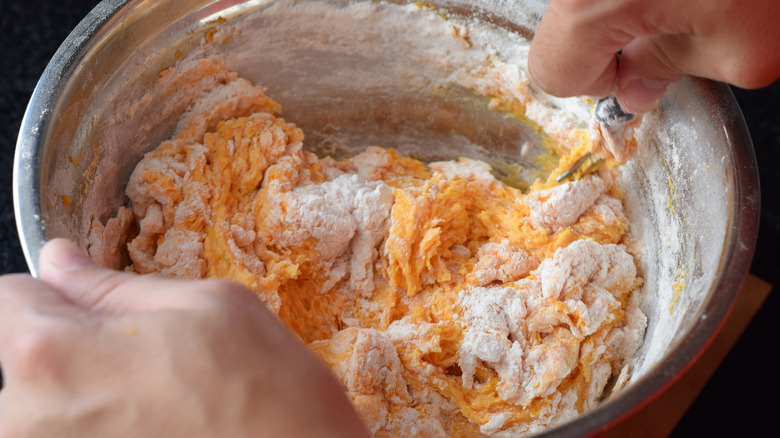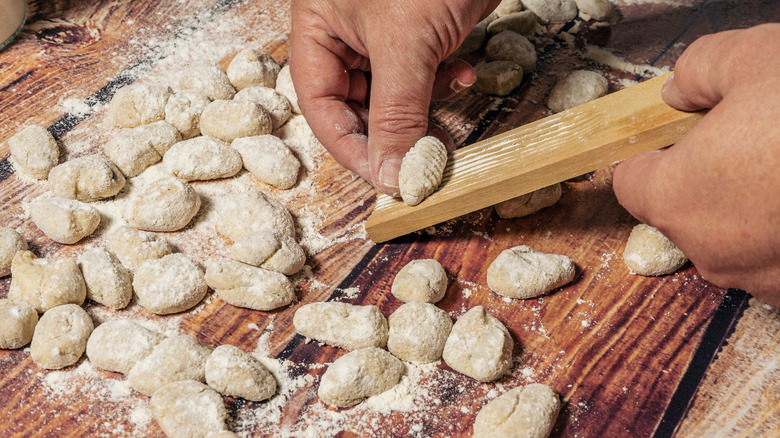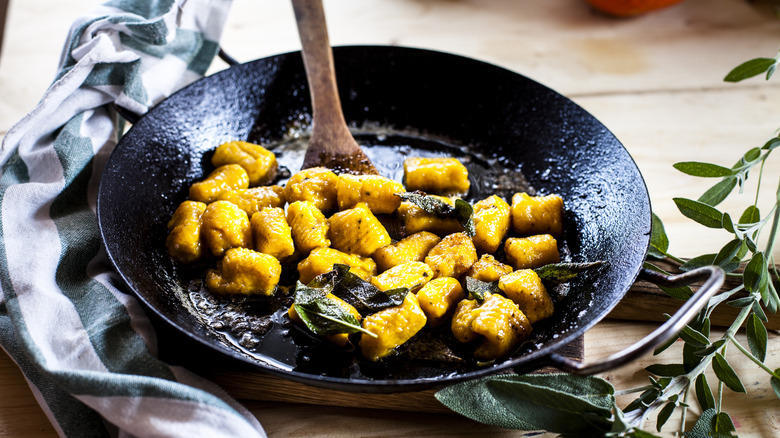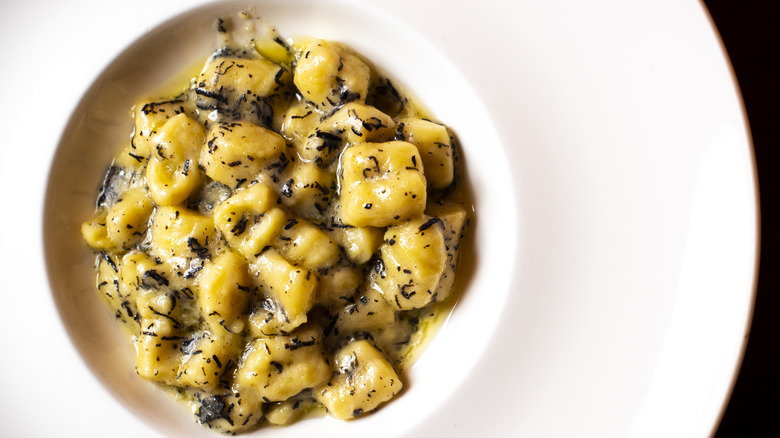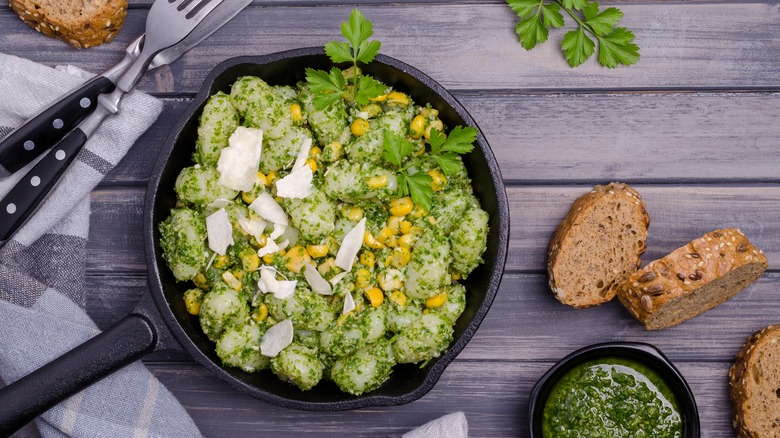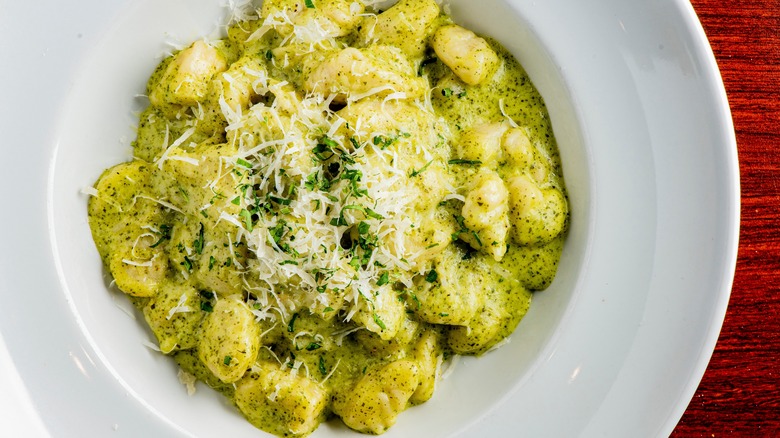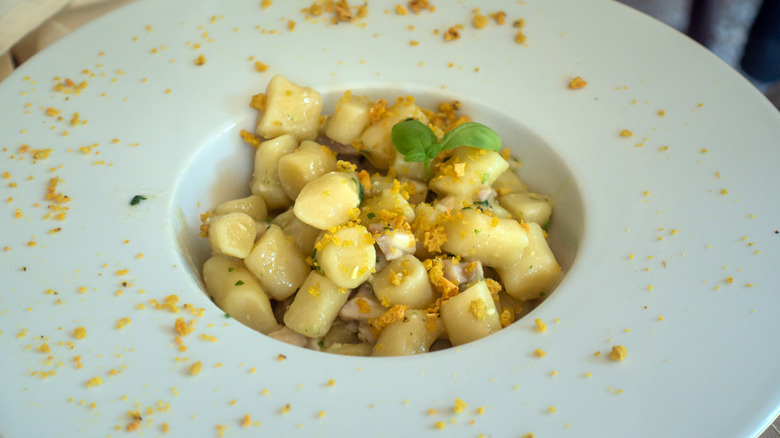12 Reasons Restaurant Gnocchi Is Always Better, According To Chefs
We may receive a commission on purchases made from links.
Gnocchi dishes are easy enough to make at home. You can grab some gnocchi from the store, make your sauce of choice, and you're well on your way to a tasty meal. But even so, it's just not the same as your favorite restaurant gnocchi. The gnocchi itself might be dense rather than light and pillowy, and the sauce or other accompaniments not as flavorful. This probably leaves you wondering why you can't get the same results.
To get to the bottom of it, we interviewed three chefs from restaurants that serve gnocchi. They let us in on some tricks of the trade to explain why professional kitchens turn out gnocchi that's so much better than what you make at home. And, we're about to share those secrets with you.
From choosing the right potatoes and cooking methods to finding the perfect sauce to pair with it and adding the best finishing touches to a gnocchi dish, there's so much that sets professional dishes apart. We're about to explore the reasons why restaurant gnocchi is always better, according to chefs.
1. Restaurant gnocchi is usually made in-house
Perhaps the biggest overall reason why gnocchi is better at a restaurant is that it's usually made in-house. Sure, there are ways to upgrade store-bought gnocchi, but you just can't expect it to taste as good as the handmade stuff.
Although you might come across some restaurants that use gnocchi from a package, any good establishment will make it in-house or leave it off the menu. "We make it fresh in-house every day," says chef Troy Guard, owner of Guard and Grace, which has restaurants in Denver and Houston. "Gnocchi are something that for many years were never on our menu, but after starting our in-house pasta program, we hand-make gnocchi to serve our guests — and ourselves as well," Michelle Durpetti, owner of Chicago's Tuscan restaurant Gene & Georgetti, tells us.
If you're trying to make restaurant-quality gnocchi yourself, there's really only one solution: make it from scratch. There are plenty of gnocchi recipes online, if you want to try making it yourself. Although there's some trial and error involved to get your technique down, it's simpler than you might imagine. You just need to make a dough from cooked potato and flour (egg is sometimes used as a binder), form the gnocchi shapes, and then cook them.
2. Chefs think about the potato variety they use
Among the many reasons why restaurant gnocchi is better than store-bought or many homemade versions is that chefs consider the potato variety they use. Store-bought gnocchi is often made with dehydrated potato, rather than fresh, and it's unclear whether manufacturers think about potato variety. And, if you've ever tried to make gnocchi yourself at home, you probably used whatever potatoes you had lying around. Chefs, however, know that the choice of potato can impact the finished dish and choose varieties carefully.
"Russets are great for so many things, and gnocchi is sure one of them," says Michelle Durpetti of Gene & Georgetti. "Their low moisture content makes them great for making gnocchi; they don't get gummy or waxy." Troy Guard tells us he also opts for russet potatoes, citing their high starch content as the reason. "The starch helps create that light, fluffy texture that makes gnocchi so delicious."
Hannah Hopkins, the owner and head chef at Mambos Italiano, also uses russet potatoes for gnocchi — so it's unanimous. That said, other starchy types of potatoes are likely to yield similar results. You should always avoid using waxy potatoes, as these are denser and less fluffy. The resulting gnocchi may turn out gummy or stodgy if you use waxy potato varieties.
3. Chefs use cooking methods that make their potatoes fluffy and not waterlogged
All chefs have their own cooking methods when cooking potatoes to use in a gnocchi dough. There's no absolute right method here, but the aim is to avoid introducing too much water into the potato. One prep mistake that people often make with gnocchi is cooking potatoes without the skin on. This results in waterlogged potatoes and ultimately gives gnocchi an unpleasant texture.
"You do not want wet potato because then you need more flour and that makes for a heavy and gummy texture," Mambos Italiano chef Hannah Hopkins tells us. Rather, "you want to go for [a] light and pillowy texture," she explains. After cooking the potatoes, "I peel the skins off and put through a potato ricer on a sheet pan until cooled off and then they are ready to use," Hopkins says. Nigella Lawson also points out that the drier your potatoes are, the less flour you'll need, and this is how you achieve a lighter texture with gnocchi.
But, this isn't the only method for preventing watery potatoes. Troy Guard says that at Guard and Grace, they rub the potatoes with olive oil, season them with salt and pepper, then bake them like a baked potato. "This method ensures the potato is dry and fluffy, perfect for the next steps of making gnocchi," he notes. So, even though gnocchi is essentially mashed potatoes mixed with flour, you can't just cook the potatoes like you would for mash.
4. Restaurants sometimes use ricotta to make gnocchi
Potato is the standard, but gnocchi can also be made with other base ingredients in the dough. Some restaurants make ricotta gnocchi, giving you a different flavor and texture. This could be why the gnocchi dishes you've made at home just don't compare.
"Currently we use a whole milk ricotta instead of potato and press in a cheesecloth for two days to remove all excess water," says Hannah Hopkins. Some good restaurants go the extra mile like this. And, honestly, it's more effort than most people are willing to put into their homemade gnocchi.
But, ricotta isn't the only alternative to potato that can be used in gnocchi. You can make sweet potato gnocchi, pumpkin gnocchi, and rutabaga gnocchi. Basically, most starchy root vegetables can be transformed into gnocchi. They bring a slightly different flavor profile. For instance, pumpkin gnocchi is significantly sweeter than potato gnocchi. You'll sometimes find these alternatives on restaurant menus.
5. Gnocchi from restaurants is usually seasoned simply
Less is more when it comes to seasoning gnocchi. According to the chefs we spoke to, gnocchi from restaurants is usually seasoned simply. So, if you've been raiding the spice rack while making these little potato dumplings, you need to rethink.
Michelle Durpetti says that salt is the only addition to gnocchi dough at Gene & Georgetti. "Most of the flavor comes from the type of potato you use," she remarks. "Some people love using Yukon gold potatoes for their sweetness, but other than pure potato flavor, fine grind kosher salt is the only addition." Troy Guard agrees that simple seasoning is the way to go. "The dough itself is kept simple with just flour, egg, salt, and pepper," he tells us. "This way, the focus remains on the potatoes and gives the sauce its chance to shine."
But, sometimes chefs make extra additions. For instance, Hannah Hopkins uses Parmesan in the dough for extra flavor. She sometimes also adds fresh herbs. These add both color and flavor to handmade gnocchi. It's not the most traditional approach, but herbed gnocchi can be delicious. So, simple is generally the way to go, but rules are made to be broken. Once you've mastered basic gnocchi, you might choose to make some changes.
6. Restaurant gnocchi isn't overworked
Overworking is one of the common mistakes people make with gnocchi. It's an error that can lead to a poor texture. But, chefs are careful not to work gnocchi dough too much, which plays a part in why restaurant versions reign supreme. "Overworking the dough can make the gnocchi tough," Troy Guard tells us. That's what you're trying to avoid and why restaurant gnocchi is often far lighter than homemade offerings.
"I was always taught that gnocchi are truly more fragile than eggs," remarks Michelle Durpetti. "Much like a pancake batter, mixing until the dough barely comes together is the key," she adds. "It's all about the feel — you really get the hang of it with practice," says Guard. "Over time, you learn how to see and feel when it's just right."
This means you can't always expect perfect results the first time around. And, that contributes to the superiority of restaurant gnocchi. When you're learning to make it at home, you might only try it a few times. Chefs will not only get training, but then make gnocchi every day for months, if not years. So, don't be disheartened if it takes a while to get the feel of it.
7. Chefs know how to form and shape gnocchi
Gnocchi from restaurants is perfectly formed. The same can't usually be said for homemade attempts. While wonky gnocchi can still be tasty, careful forming helps them stay pillowy and light, while adding ridges to them means they hold onto sauce better.
Generally, gnocchi is formed by rolling the dough with your hands into a long rope. You then cut this rope into individual pieces. "Shape them however you like, but typically [a] thumb's width is perfection," notes Michelle Durpetti. "Traditional gnocchi tends to be a bit puffier and larger, but at Guard and Grace, we like to go for a slightly smaller size," Troy Guard tells us.
Not everyone shapes their gnocchi this way, though. "Take a small amount and make it into a little ball, rolling it out with your hands," Guard instructs. "Depending on the size, you can easily use your hands and roll it out." Forming each gnocchi individually gives it a smoother shape that's more like ones you might find at the store.
But, what about those ridges? "If you want ridges, use a gnocchi board or a fork to shape," says Hannah Hopkins, noting that the ridge helps the sauce to stick. "However, shaping them into ridgeless little pillows is perfectly acceptable," she adds.
8. Gnocchi from restaurants may be pan-fried
Wondering why the gnocchi you eat at restaurants is always slightly crisp on the outside, when the ones you make at home are soggier? Well, restaurants sometimes pan-fry gnocchi to give it that crunch. There's no right or wrong answer between boiling and frying, but if you want crispiness, your gnocchi needs to hit a hot pan.
Some chefs, including Troy Guard of Guard and Grace use both methods in combination to get their desired result. "Boiling gives the gnocchi that soft, pillowy texture, and a quick pan fry adds a light crispiness," he tells us. "It's the best of both worlds, but not the traditional way of preparing."
Chefs also know what textures they're looking to achieve and may adjust the cooking method depending on the rest of the dish. "I like to boil and then pay-fry if making a butter sauce," says Hannah Hopkins of Mambos Italiano. However, she adds, "If I am adding gnocchi to a ragu or a tomato sauce, I prefer to boil." This kind of nuance can be what turns a good dish into a great one.
9. Chefs know what sauces and other ingredients to pair with gnocchi
You can make perfect gnocchi, but if you don't know what to pair it with, this dish can fall flat. Yes, the gnocchi itself is a vital part of the finished meal, but the other elements are important, too. Chefs know how to make great sauces to go with gnocchi and think carefully about what other ingredients to add, such as veggies and proteins. They have the knowledge needed to balance a dish properly and make it outstanding.
"Gnocchi absorb lots of flavor, so saucing can be as simple as some really good Parmigiano-Reggiano and butter, all the way to a traditional quattro formaggi (four cheese) sauce," says Michelle Durpetti. "Choose flavors that are classic and simple, so they don't overpower the gnocchi," she adds. Hannah Hopkins likes gnocchi with pancetta, peas, gorgonzola, brown butter and sage, or a lobster sauce. "I also love a long cooked sauce like Bolognese or short rib ragu," she remarks.
According to Troy Guard, gnocchi's subtle flavor makes it a bit of a blank canvas, so it's a perfect match for almost anything. "I like pairing it with truffle oil and chives, but you can also use fresh vegetables or different meats," he tells us. "The possibilities are truly endless with this dish." When thinking of ingredients to pair with gnocchi, "at Guard and Grace, we like to keep it fresh and seasonal," Guard says. He lists grilled vegetables, heirloom tomatoes, fresh herbs, and good olive oil among his favorite pairings.
10. Restaurant gnocchi is properly tossed with the sauce
Like pasta, it's pretty common for people to cook gnocchi, put it on the plate plain, and then dump the sauce over the top. But, this isn't the best way to do it. Chefs know that gnocchi should be mixed with the sauce for the best results. This helps you get an even distribution, so you aren't left with some plain pieces of gnocchi and some overly saucy mouthfuls.
"Making sure to properly toss the gnocchi (carefully) in the pan with the sauce is really important to getting a beautiful silky texture and allowing the gnocchi to soak up as much flavor as possible," Michelle Durpetti explains. So, it's not just about distribution, but also the overall texture and flavor of the dish.
As you should with pasta, if you've boiled your gnocchi, you can add a little bit of the cooking water when you mix it with the sauce. This salty, starchy water improves the sauce so it's flavorful and silky smooth, rather than thick and sticky.
It's such a simple step, but it can make all the difference to the finished dish. After combining the gnocchi with the sauce, you can plate it up and then add the veggies or protein you're serving with it on top or on the side. Of course, gnocchi at restaurants is usually beautifully plated, so it looks as good as it tastes.
11. Chefs add finishing touches to gnocchi dishes
Chefs know what kind of finishing touches to add to gnocchi to make a dish special. A smidge of this and a drizzle of that can take a simple dish and take it to the next level. Chefs are masters of this, which is part of why food at good restaurants is so much better than what the average home cook whips up in their kitchen.
But, what kinds of finishing touches might chefs add to gnocchi? "I love to add Parmesan to my gnocchi recipe but it's very important to always use the high-quality ingredients while making gnocchi," says Hannah Hopkins. So, no bags or pre-grated hard cheese. You should use the good stuff. "I always love to finish all my pasta with a single estate first cold-pressed olive oil," Hopkins adds.
Some chefs keep it even simpler on the finishing touches. "A sprinkle of salt and pepper at the end does wonders," Troy Guard remarks. "It enhances the flavors of the dish and really brings out the best in whatever ingredients you use." You might also add fresh herbs or a drizzle of infused oil. Anything to add some flavor or texture is great.
12. Gnocchi from restaurants is perfectly cooked
Both overcooking and undercooking gnocchi can be an issue. It doesn't take long to cook, so it's easy to overcook. It can quickly go from light and fluffy to tough and rubbery. But, this makes some people overcautious, so they'll undercook it, meaning the center is still doughy and dense.
"I think whether at home or in a restaurant, overcooking is the biggest mistake people make," says Michelle Durpetti. However, it's not that hard to tell when gnocchi are cooked if you know how. "When they float in your boiling salted water, pull one out," Durpetti advises. "If it bounces back, it's perfect" but "if it smashes, it isn't cooked yet."
Generally, gnocchi only need a few minutes of boiling in salted water until they're done. When pan-frying your gnocchi, you'll know it's done when each side is lightly golden and crispy. The length of time this takes varies depending on factors such as the heat and the size of the gnocchi.
